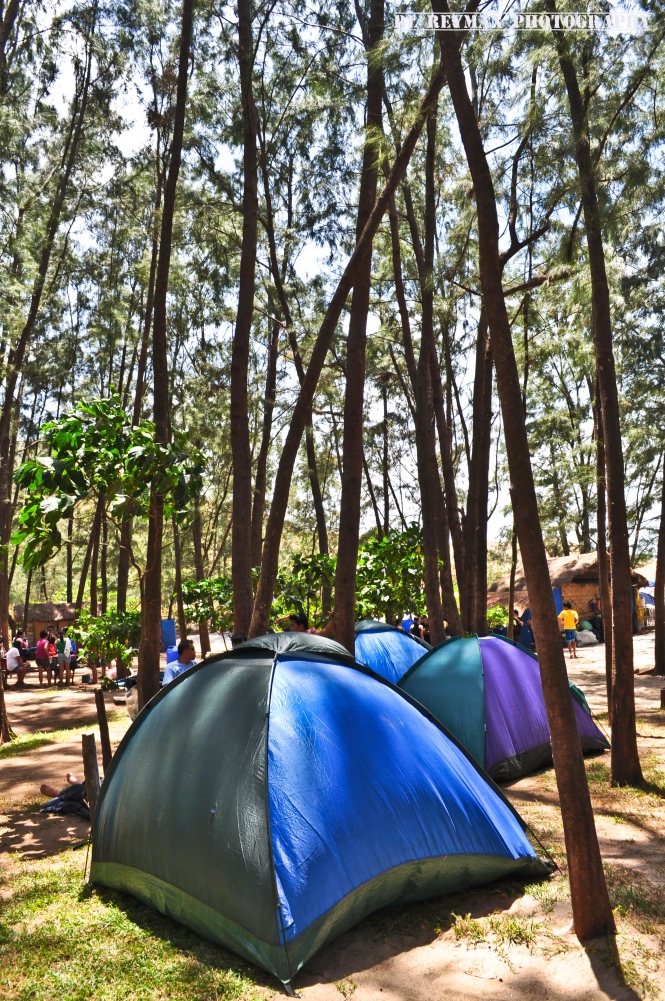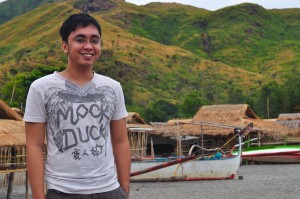I now have the guts to share this story:
On the 21st of June 2009, my college friends and I set our first reunion. It would be our first, and also Mackie’s first time go home after being relocated to Singapore for a better job. Since the time calls for a celebration, we all decided to make it different and have an out of town trip to Zambales. With Mackie shouldering the expenses for accommodation and food, 11 among our batch joined.
June is rainy month in the Philippines. But it never stopped us to proceed with our plan of going to the beach. It was raining hard when we arrived at Pundaquit, making us all in agreement to abandon our island hopping activity the next day. Same day, I also received a call from my parents warning me not to go to Anawangin due to bad weather. I assured them.
Come next morning, the cloudy skies were suddenly wiped out by the sun. This had raised our hopes and brought our initial plan to life. We immediately contacted a boatman if we could sail to Anawangin since it was getting sunny. Upon his approval, we then proceeded.
We were ferried by three small boats. It was a smooth ride at the onset, until all of a sudden, we were smacked by the treacherous waves. The clouds turned gray and the wind started to blow tough across an angry sea. It was a no-turning-back moment, so our boat strove steadfastly against the murky waves. It wasn’t that easy. Our boatman had to give his best to dock us safe. After battling with the strong current, we managed to reach the ground.
I turned pale upon taking my first paces on the fine shore of the cove. It was the first time my friends saw me in great tremor because I just stayed in one corner and was quiet the whole time. I was actually worrying about our way back which prompted me to bring up a crazy idea by suggesting that we should trek the mountain instead.
I didn’t know why fear was very dominant in me albeit we have life jackets, I could swim, and I was used to sailing rough seas before. Maybe I worry not for myself but for the lives of my friends who were with me. I couldn’t disregard myself from the equation if something bad happened to us because it was my idea in spite of the caveat from my parents.
When it was already drizzling, we all got up the shore to leave. I thought we were going back to Pundaquit but my friends still wanted to go to Capones island. I refused adamantly. However, after so much convincing and prayers, I unwillingly joined the club.
Two hours passed and we were back at Pundaquit coast safely. From then, I became a laughing stock of my friends whenever we reminisce our trip to Zambales. They were the adventurous guys, and I was the coward one. Now, I have finally got over that embarrassment and learned to laugh about it too.
This experience has given me more reason to visit Anawangin during dry season. Just last week, I made it back. And Yes, it was love at second sight.
Anawangin Cove lies in San Antonio, Zambales. It’s a 30-45-minute boat ride from the shores of Pundaquit. It is a beach enclosed by mountains. The existence of pine trees does not only add beauty to the place but makes the cove more rustic and enigmatic.
I decided to spend the whole afternoon in Anawangin after having a brief stay at Camara and Capones islands throughout the morning. It was totally different from the first time I saw it. Murky water during wet season turned into glowing bright-green and blue. The entire sea was calm and appeared to be very accommodating to us. Visiting it in March was a perfect timing because most travelers start exploring Anawangin in April—the official vacation month of students. Deviating from the peak season gave me more time to enjoy its serenity and devour its gratis charm.
Behind the pine trees reclines a river that contributes to the stillness of the place. It stretches along the whole curve of Anawangin. However, there’s no portion where the sea and river intertwine. The beach offers its fine gray sand. Unlike other islands in Zambales, though it’s not white, Anawangin has the perfect beach sand. There’s no rough part and it’s powdery.
There’s no concrete infrastructure in Anawangin which for me is better in order to preserve its uniqueness. Looking for shades is not a problem since trees are very abundant everywhere. This is also the reason why campers prefer to stay here over night.
To those who are looking for a perfect getaway this summer, include Anawangin cove in your list as early as now. Go ahead. Be astounded. I’m sure you will appreciate it and maybe, also fall in love with it instantly at first sight.
IMPORTANT POINTS TO REMEMBER:
Make sure to make reservations before your trip. It will save you time, money and energy. I attached the details of my contact person below.
1) Anawangin is divided into several resorts. I recommend you stay at Mansayon Beach Resort. Entrance fee for day trip is P50 and P100 for overnight stay. So far, it’s the best resort in the area. Though all resorts are almost the same, Mansayon has the best location. Wooden tables and benches are also provided for free.
2) If you don’t have a tent, you could rent at a store managed by Ligaya Mansayon or in some resorts located in Pundaquit. If you already have a contact person, I suggest that you ask him to reserve tent for you.
3) You will be able to use your phone only to take pictures or play music. There’s no cellular signal in the area. If you’re not with your special someone, forget him/her first. It’s the best time for you to enjoy your freedom. (Haha!)
4) Save your battery. There’s no electricity in Anawangin. Most campers bring battery-operated lamp. Firewoods are being sold in the area for P120 per bulk.
5) Bring enough food and water if you’ll stay overnight. The water from water pump in Anawangin is not potable. If possible, do not buy food in any stores in Anawangin to protect your pocket from harm. Goods are expensive. Example: 1.5-liter soft drink- P80, litro pack juice- P20, ice-P20, shampoo-P10. It’s always double the price of retail store. Although I understand the store owners because the beach is isolated.
6) There are comfort rooms in the area. No shower. Learn to fetch water from the pump. Deal with it and stop complaining.
7) Don’t swim at night especially when you’re drunk. Again, no electricity. It’s hard to see people in the sea.
8) There’s no corkage fee.
9) Bring plastic bag and dispose your waste properly. Every visitor shall observe cleanliness in Anawangin.
Here’s the best deal I found:
Contact person: ALVIN BONAN
He’s also an owner of a small resort in Pundaquit.
Amenities: If you want to stay in Pundaquit, there are cottages available for P400-600. It’s a small Nipa hut, with bamboo bed and table inside. Shower rooms will be renovated next week, according to the owner. Two video-oke machines are also provided.
Contact numbers: 0928-779-9849 and 0917-993-5166
RENTALS
TENTS: 2pax- P250, 4pax- P400
BOATS: (Round trip) From Pundaquit to
Anawangin Cove- P200-250/ pax
Capones Island- P200-250/ pax
Camara Island- P200-250/ pax
Nagsasa Cove- P300-350/pax
Taliyasin -P300-350/pax
Smallest boat can carry 4-5 pax. Largest or the ferry boat can carry a minimum of 20 pax. Kuya Alvin can also provide a service (tricycle) to pick you at San Antonio Market.
Prices are always negotiable so please learn how to negotiate. You can get the best deal if you choose to go to two or more islands.
HOW TO GET TO ANAWANGIN COVE
Using a public transport
1- Ride a bus bound to Iba, Zambales or Sta. Cruz, Zambales. There are Victory terminals in Caloocan (Monumento), Cubao, Sampaloc and Pasay.
2- Get off at San Antonio Market.
3- From there, ride or rent a tricycle to Pundaquit.
4- From Pundaquit, rent a boat to bring you to Anawangin.
Approximate travel time is 4 hrs from Manila to San Antonio through public transport. But it would only take you 3-3 ½ hrs if you have a private vehicle. Of course, it varies on the time of your travel.
(Date of travel: March 19, 2011)












